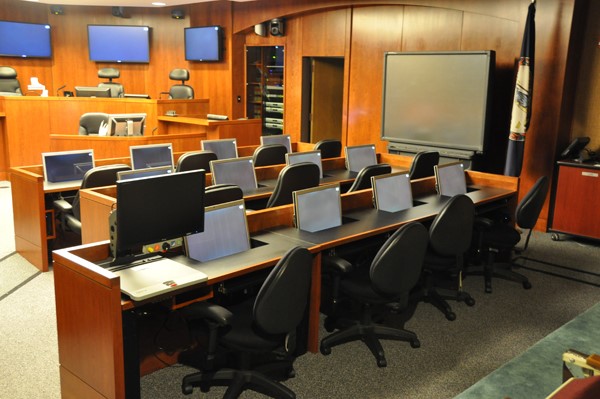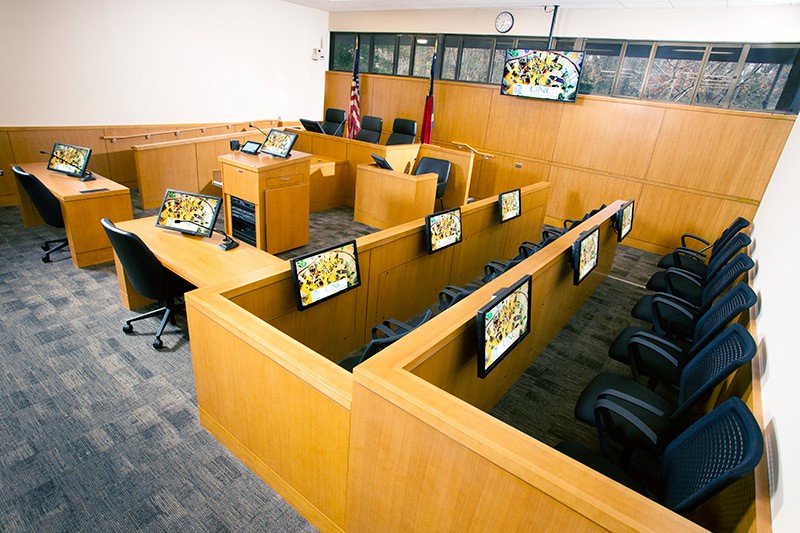The fundamentals of trial and courtroom procedures have remained unchanged for hundreds of years, but the effects of the technology revolution on the practice of law over the past few years are undeniable.
Studies have long supported that both comprehension and retention of information is increased when presented with supporting audio and/or visual aids. Borrowing from the education world, audiovisual technology has become as essential in courtrooms as it is in classrooms. However, the way these systems are designed can vary widely, which impacts the effectiveness of the presentation.
What are the digital presentation system options?
Aside from the different input systems (evidence presentation, digital inputs etc.) the most common courtroom presentation systems to display those inputs are:
- Projector and screen
- Flat panel displays
Projector and screen systems have undoubtedly been around much longer than flat panel displays, especially when considering the lamp-based bulb projector technology which has been widely used for decades. In comparison, flat panel display technology has seen vast technology innovations and price reductions over the last 10 years.
Projector and screen
Since about 2015, the advent of laser lamp technology has, in many ways, re-established the power and flexibility of the projector and screen system. The new laser lamp technology has overcome one of the biggest objections to projection, the lifespan of the light source. This equipment has gone from a 3,000 – 5,000-hour life expectancy to up to 20,000 hours of life expectancy with minimal maintenance.
Flat panel displays
The improvements in projector and screen do not amount to declaring flat panel displays as inadequate presentation technologies. On the contrary, flat panel displays are still great tools that can be used, but their limitations must be understood. Flat panel displays are easily mounted, affordable, and can be integrated within built elements with a little design consideration.
One issue, however, is that flat panel displays become cost prohibitive at around the 90-inch diagonal screen size. This means that more displays may be needed in some applications, depending on how far the audience may be. When more displays are required, there are larger architectural design and infrastructure implications which are specific to the needs of the courtroom condition.
From a cost standpoint, a 40-inch display generally costs in the $200-$300 range while the cost of a 90-inch display can easily exceed $5,000 or more.
What should we consider in digital presentation systems for courtrooms?
Presentation systems are all about sharing information for an audience to gather, process, and retain. The use of this technology and its efficiency has been widely studied in the education environment and is clearly seen in the shifting teaching styles in classrooms around the world.
Borrowing from the Active Learning Classroom
The latest trend in education is the active learning classroom which uses both projectors and screens, as well as digital flat panel displays. The projector screen is used as the larger presentation surface for use during a classroom-wide presentation, while the displays are used when the classroom breaks out into smaller individual groups. This pedagogy has proven to be the most effective in aiding students in understanding and retaining the content being disseminated. A similar approach can be applied to the courtroom where the larger screen is used when the intent is to uniformly address a group and capture their attention, while smaller screens would be more likely seen in deliberation rooms as in a “break out session” in an active learning classroom.
Architectural and Operational Implications
When discussing presentation systems specific to any environment, the considerations move past the technology itself into the architectural and operational implications of the systems being considered. The “experience” that is intended to be portrayed should also be an important factor considered in the decision-making process. It is important to note that neither the projector nor flat panel display system is the universally better technology for courtrooms. This is a decision that needs to be made in the context of reviewing the specific courtroom architectural design being considered.
Courtroom Size
Smaller courtrooms where the viewing distance from all intended audience members in adequate ranges for displays under 90” can effectively consider the use of flat panel displays mounted to walls in strategic locations. Larger courtrooms that require a larger screen size due to viewing ranges should consider the use of projection screens, for the reasons previously stated, or consider multiple flat panel displays mounted to the walls at adequate locations. Additionally, smaller supplemental displays (i.e. computer monitors) can be considered where desktop locations such as the judge and attorney tables.
Jury Box Implication
The remaining location, at the jury box, presents the most unique consideration when deciding between the use of a larger projection screen, a large wall mounted flat panel display, or even individual flat panel displays for the jurors at the jury box itself. There are several factors to be considered here – the sightlines that need to be maintained for all jurors, the location where these displays can be mounted, the infrastructure needed for these individual displays, and the experience of the juror that needs to view the display.
Future-Proofing Presentation Technology
From a simple future-proofing perspective, adding fixed displays inside a jury box is the least flexible solution. These displays would be permanent and could only be replaced with others of similar form factor in the future. Additionally, displays that are mounted in the jury box but not recessed into the furniture are at risk of being damaged and used as leverage when entering, sitting, and standing in the box. This is a common occurrence in environments where a wall mounted display is at arm’s reach of a seated individual, and they proceed to use the equipment to help them stand or move around the space. Also, if the equipment is not recessed, the power and data cabling may be exposed and could be accidentally bumped, removed or turned off. If the displays are capable of being fully recessed, those issues will be mitigated but a proper ventilation and accessible design should be ensured.
Juror Experience
Considering the experience of the juror, a design in which two or more rows of jurors must view a display mounted to the first row could very easily have the second row (and beyond) outside adequate viewing ranges. It will also be tough to locate these in the natural field of view of all jurors (to avoid them having to shift and move, which breaks their concentration) without requiring extensive architectural support. The jurors at the front row will likely be repositioning the displays for their best viewing, forcing the second rows and beyond to move around to see or interrupt the jurors and ask them to move the screens. It is feasible to expect this to happen during a trial and not just at the beginning when jurors enter the box, but during the time when evidence is being displayed and images are changed on the screens (different images will have different contrast, sizes, brightness etc.). During this, the attention of the juror goes away from the evidence being portrayed and the presenter speaking. Engagement and focus may decrease in this scenario and each juror may have a different experience or level of retention and understanding of what they are being shown.
Alternatively, if the architecture can support this, an individual screen for each juror may be mounted directly in front of them. This would allow for less interruption between jurors but will require additional infrastructure and maintenance.
Psychology of Video
Psychology of video is largely the factor of the “digital campfire,” meaning that optimization of attention span is about field of view (or how large the image is in minutes of arc), brightness, and contrast (how much it stands out from the background and how crisp and sharp it is). These are all factors that can only be uniformly controlled if jurors are looking at a shared screen as opposed to each having their own displays to look at, with their own settings to be calibrated.
Individual or Shared Experience
An important part of the user experience is also the sense of whether an experience is shared or individual. Two people viewing the exact same content on individual displays at the same time will not have a sense of a shared experience near the same way as two people watching it together on a shared display. Deciding the intended experience for the courtroom may be important in this scenario. Theoretically, the ideal technology experience would be the one that most closely matches the experience of having someone approach the jury box with a piece of evidence, instead of handing out 12 photos to each of the individual jurors.
Other Technical Considerations
Lastly, a more technical consideration to keep in mind is whether your courtroom will also require other inputs such as document cameras, DVD players, etc. A system that requires a higher number of inputs and has a larger number of outputs (individual vs. shared displays) is a more complex system that requires additional headend equipment to convert and route the signals properly.
The ultimate solution chosen must be done while considering the operational, architectural, and technical implications of each option. There are no universally correct solutions, but if you explore each of the factors described above, you are well on your way to figuring out the best fit for your specific situation.
Associate Michael Niola contributed to this blog post. Mike is currently the project manager for Vantage’s projects at the Sacramento Criminal Courthouse and the Redding Courthouse.



